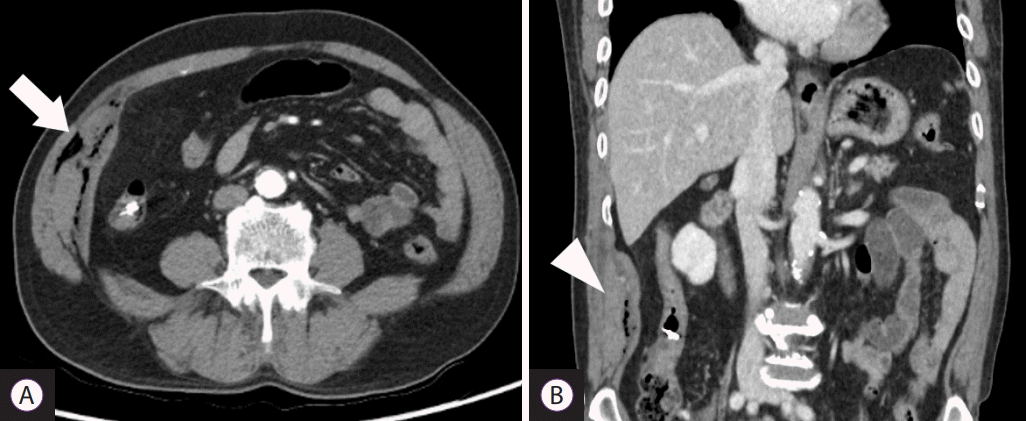1. Aronoff DM, Bloch KC. Assessing the relationship between the use of nonsteroidal antiinflammatory drugs and necrotizing fasciitis caused by group A streptococcus. Medicine (Baltimore). 2003; 82:225–235.

2. Stevens DL, Bryant AE. Necrotizing soft-tissue infections. N Engl J Med. 2017; 377:2253–2265.

3. Misiakos EP, Bagias G, Patapis P, Sotiropoulos D, Kanavidis P, Machairas A. Current concepts in the management of necrotizing fasciitis. Front Surg. 2014; 1:36.

4. Lamagni TL, Darenberg J, Luca-Harari B, et al. Epidemiology of severe streptococcus pyogenes disease in Europe. J Clin Microbiol. 2008; 46:2359–2367.
5. Huang KF, Hung MH, Lin YS, et al. Independent predictors of mortality for necrotizing fasciitis: a retrospective analysis in a single institution. J Trauma. 2011; 71:467–473. discussion 473.

6. Wong CH, Chang HC, Pasupathy S, Khin LW, Tan JL, Low CO. Necrotizing fasciitis: clinical presentation, microbiology, and determinants of mortality. J Bone Joint Surg Am. 2003; 85:1454–1460.
7. Anaya DA, McMahon K, Nathens AB, Sullivan SR, Foy H, Bulger E. Predictors of mortality and limb loss in necrotizing soft tissue infections. Arch Surg. 2005; 140:151–157. discussion 158.

8. Orlando A, Marrone C, Nicoli N, et al. Fatal necrotising fasciitis associated with intramuscular injection of nonsteroidal anti-inflammatory drugs after uncomplicated endoscopic polypectomy. J Infect. 2007; 54:e145–e148.

9. Frick S, Cerny A. Necrotizing fasciitis due to streptococcus pneumoniae after intramuscular injection of nonsteroidal anti-inflammatory drugs: report of 2 cases and review. Clin Infect Dis. 2001; 33:740–744.
10. MacLean AA, Miller G, Bamboat ZM, Hiotis K. Abdominal wall necrotizing fasciitis from dislodged percutaneous endoscopic gastrostomy tubes: a case series. Am Surg. 2004; 70:827–831.
11. Calderon E, Carter E, Ramsey KM, Vande Waa JA, Green WK, Alpert MA. Necrotizing fasciitis: a complication of percutaneous coronary revascularization. Angiology. 2007; 58:360–366.

12. Nouira K, Bourkhis S, Maalej S, et al. [Necrotizing fasciitis complicating transthoracic biopsy]. Rev Pneumol Clin. 2007; 63:273–276.
13. Pryor JP, Piotrowski E, Seltzer CW, Gracias VH. Early diagnosis of retroperitoneal necrotizing fasciitis. Crit Care Med. 2001; 29:1071–1073.

14. Devin B, McCarthy A, Mehran R, Auger C. Necrotizing fasciitis of the retroperitoneum: an unusual presentation of group A streptococcus infection. Can J Surg. 1998; 41:156–160.
15. Sarani B, Strong M, Pascual J, Schwab CW. Necrotizing fasciitis: current concepts and review of the literature. J Am Coll Surg. 2009; 208:279–288.

16. Zacharias N, Velmahos GC, Salama A, et al. Diagnosis of necrotizing soft tissue infections by computed tomography. Arch Surg. 2010; 145:452–455.

17. Anaya DA, Dellinger EP. Necrotizing soft-tissue infection: diagnosis and management. Clin Infect Dis. 2007; 44:705–710.
18. Ryssel H, Germann G, Kloeters O, Radu CA, Reichenberger M, Gazyakan E. Necrotizing fasciitis of the extremities: 34 cases at a single centre over the past 5 years. Arch Orthop Trauma Surg. 2010; 130:1515–1522.
19. Leiblein M, Marzi I, Sander AL, Barker JH, Ebert F, Frank J. Necrotizing fasciitis: treatment concepts and clinical results. Eur J Trauma Emerg Surg. 2018; 44:279–290.

20. Cheng NC, Tai HC, Chang SC, Chang CH, Lai HS. Necrotizing fasciitis in patients with diabetes mellitus: clinical characteristics and risk factors for mortality. BMC Infect Dis. 2015; 15:417.


